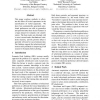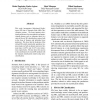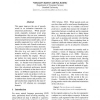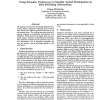ACL
2009
13 years 7 months ago
2009
This paper explores methods to alleviate the effect of lexical sparseness in the classification of verbal arguments. We show how automatically generated selectional preferences ar...
NAACL
2010
13 years 7 months ago
2010
This work incorporates Selectional Preferences (SP) into a Semantic Role (SR) Classification system. We learn separate selectional preferences for noun phrases and prepositional p...
ACL
2010
13 years 7 months ago
2010
We present a system that automatically induces Selectional Preferences (SPs) for Latin verbs from two treebanks by using Latin WordNet. Our method overcomes some of the problems c...
ACL
2010
13 years 7 months ago
2010
This paper improves the use of pseudowords as an evaluation framework for selectional preferences. While pseudowords originally evaluated word sense disambiguation, they are now c...
ACL
2010
13 years 7 months ago
2010
The computation of selectional preferences, the admissible argument values for a relation, is a well-known NLP task with broad applicability. We present LDA-SP, which utilizes Lin...
COGSCI
2002
13 years 9 months ago
2002
Selectional preferences have a long history in both generative and computational linguistics. However, since the publication of Resnik's dissertation in 1993, a new approach ...
ANLP
2000
13 years 10 months ago
2000
We propose a method for identifying diathesis alternations where a particular argument type is seen in slots which have different grammatical roles in the alternating forms. The m...
EACL
2003
ACL Anthology
13 years 10 months ago
2003
ACL Anthology
Previous work on the induction of selectional preferences has been mainly carried out for English and has concentrated almost exclusively on verbs and their direct objects. In thi...
EMNLP
2007
13 years 10 months ago
2007
In this paper, we consider the computational modelling of human plausibility judgements for verb-relation-argument triples, a task equivalent to the computation of selectional pre...
LREC
2010
13 years 10 months ago
2010
This paper presents a comparison of three computational approaches to selectional preferences: (i) an intuitive distributional approach that uses second-order co-occurrence of pre...




